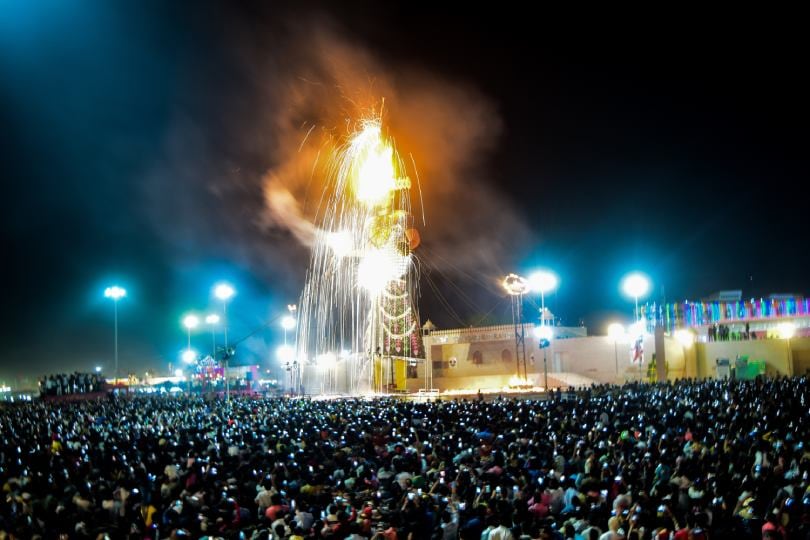

dussehra ravan stock photo, Indian festival celebration, Diwali
Interestingly, India is a culturally diverse country, so there is never a single tale behind a celebration! Lord Rama defeated Ravana in ancient times, and an effigy of Ravana is burned to commemorate that triumph. Moreover, Durga Puja is celebrated in West Bengal to signify the event of how Goddess Durga slew a wicked monster named Mahishasura. Dussehra has long been revered as a symbol of victory over evil. The name represents the festival’s importance, symbolising the sun’s rising after the defeat of the ten-headed Ravana. It is derived from the Sanskrit term ‘Dash Hara‘, which means the sun’s defeat.
Vijayadashmi, commonly known as Dussehra, is a Hindu festival celebrated annually at the end of Navratri. On the 10th day of Ashvina, the celebration is marked with tremendous victory and optimism. On the appearance of a full moon, the month of Ashvina is September through October. On the auspicious day of Dussehra, towering effigies of Ravana, representing evil, are set ablaze with fire (mainly with the bow and arrow, which Ram used to slay Ravana), signifying evil’s destruction. The festival is majorly celebrated for two significant mythological events. People in the nation’s north perform a must-see recreation of Ram Ravana-vadh. You may also arrange a family trip to Varanasi or stay in any family hotel near the place to experience the custom.
Ravana kidnaps Sita in the forest, and Rama recruits an army of monkeys and bears to look for her. When both sides of Ravana and Ram declared battle, deity Ram vanquished Ravana’s evil entity with his bow and arrow.
It also commemorates the death of the demon Mahishasura by goddess Durga; the festival is also a celebration of feminine divinity. The event, also known as Vijayadashami, is held after the nine-day-long Navratri holiday.
Like any other festival celebrated in Indian culture, Dussehra is associated with certain mythologies and stories. Look at some of the most exciting and lesser-known facts about the festival.
1. Based on certain Hindu mythologies, Dussehra is celebrated after Navratri because Lord Ram is said to have worshipped Goddess Durga before embarking on his quest to defeat Ravana under Lord Vishnu’s guidance. Lord Rama conducted the Chandi Homa Yajna to get Devi Durga’s blessings. Devi Durga bestowed a bow and arrow on Lord Rama for him to battle evil.
2. Apart from the well-known Dussehra celebration in Mysore, the celebration of this event in the Kullu city of Himachal Pradesh has also received attention. This celebration lasts approximately a week, and people from all over the country travel to Kullu to participate. You can also be a part of it, and you need not worry about the stay as you can find numerous family hotels in Himachal, like the OYO 82777 Hotel Alfa.
3. Dusshera is derived from two Sanskrit terms, Dasha and Hara, which signify Sun and Defeat, respectively. The thundering actions of the demon Ravana were at their peak, and it was believed that if he were not destroyed, the sun would not rise. Lord Rama had to conquer Ravana, and the sun rose in splendour.
4. Goddess Durga and her offspring Lakshmi, Kartik, Ganesha, and Saraswati are also said to have visited her birthplace and stayed there for a while. The Goddess returned to her husband, Lord Shiva, on the occasion of Dussehra.
5. Although Ravana was a symbol of evil and wrong in Hindu society, many acknowledge his wisdom and knowledge. Ravana’s ten heads represent his immense knowledge of six sastras and four Vedas, which is why Ravana is also a symbol of intelligence and wisdom in society.
6. Dushera is well-known throughout India, but the holiday celebration, particularly in Mysore, has grown in popularity. The entire city is illuminated and coloured at the Mysore palace. The Jambu Savari, or Elephant parade, is one of the festival’s most popular festivities. Twelve trained elephants clad in colourful costumes are escorted around the streets during this procession. One of them is holding Chamundeshwari’s idol, which is mounted on a golden mandap. You can quickly look for family hotels in Mysore to plan a trip to the glorious palace during the season.
The auspicious day of Dussehra is celebrated with tremendous joy and happiness throughout the country to signify the importance of several Indian mythologies. A lot of tourists visit the cities of Mysore, Varanasi, Himachal Pradesh and Kolkata to get a glimpse of the celebration and learn about its history and importance. You can also plan a trip to one of these places during this Dussehra. If you’re travelling with your friends or family and want to experience the sights for 11 days, you might look for family hotels near you to make the trip fun and relaxing.
Noida, with its vibrant culinary scene, offers a plethora of options for dessert lovers craving…
Embarking on a journey? Make your travels more convenient and enjoyable with the latest accessories…
As the temperature drops and the chilly winds start to blow, staying warm and healthy…
Travel photography is not just about capturing moments; it's about immortalising experiences, landscapes, and the…
Embarking on a solo adventure can be exhilarating, offering the freedom to explore new destinations…
Business travel often entails tight schedules and hectic itineraries, leaving little room for packing mishaps…